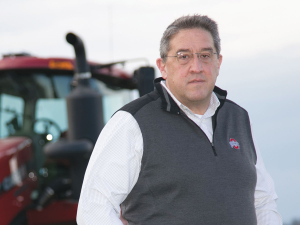Three new grower directors appointed to FAR board
Effective from 1 January 2026, there will be three new grower directors on the board of the Foundation for Arable Research (FAR).
 Professor Scott Shearer, Ohio State University believes robotic tractors are on their way and could eventually remove people from the fields.
Professor Scott Shearer, Ohio State University believes robotic tractors are on their way and could eventually remove people from the fields.
Autonomous tractors are coming to a paddock near you.
And the big question is how quickly these robotic tractors will remove people from the field.
The observation was made by Scott Shearer, Professor and Chair of Food, Agricultural and Biological Engineering at Ohio State University, during his address to Foundation for Arable Research's Maize Profit and Productivity conference held recently at Hamilton.
"Previously it was start-ups talking about autonomy but now it is all tractor manufacturers. It will be one of the things that will chnage the marketplace. Autonomous tractors are coming to market, with the only question being how quickly these will remove people from the field," Shearer told the audience via video link.
He spoke on the current and future role of precision agriculture in the US, citing the example of Australian company SwarmFarm who use the tagline 'My Dad used to drive a tractor'. SwarmFarm's autonomous sprayer can operate 24/7 and can automaticall shut down in adverse weather.
Looking at the practicalities of using such systems, autonomous systems require 5G connectivity which is not always available in rural areas. However, some US farmers have become their own cell phone provider within a 2-3km radius, by using a supplementary antenna on a grain elevator.
Whether it is tractors, combine harvesters or drones, agricultural machinery is getting bigger, partly in response to changing weather and to maximise coverage in the field during optimal conditions.
Shearer suggested that as tractors became increasingly high tech and expensive, it is a question of how fully they are utilised, both in terms of operator ability and hours operated, to justify the cost.
"High speed planting is a real possibility with the technology working well at speeds of 10 to 16km/h. But there are challenges to moving to higher speeds in the field," he says.
Agrichemical application using drones is also ramping up in the US where for example, in Ohio, around 25 companies are spraying fungicides on maize and soybean crops using the technology. One group claimed to have sprayed 10,000 hectares with eight drones, while another with two drones sprayed 2000ha in a 30-day window.
Of course, like the rest of conventional farm equipment, drones are getting bigger, with a Hylio AG-272 spray drone weighing 175kg when fully loaded with batteries and 70 litres of product, allowing it to delive a 12 metre application width, spraying up to 20ha/hour.
Interestingly, Professor Shearer also suggests artificial intelligence (AI) will assist farmers to interpret the substantial amounts of data generated using precision agriculture.
"We've evolved from precision agriculture to digital agriculture," says Shearer.
"Digital agriculture is broader, covering everything from when the seed goes in the ground until there are end products on the consumer's table. Everything is connected to the internet."
Digital agriculture applies artificial intelligence and machine learning (AI/ML), to interpret vast amounts of data to support a farmer's decision-making and improve the efficiency of farm operations.
Shearer gave the example of an AI-driven spray applicator, using a camera/processor combination to distinguish green on brown and in some cases green on green. He suggested the machinery could do a lot more than just to spray weeds, with the ability to manage fungicides, insecticides, and nutrients.
FAR technology manager Chris Smith says the biggest challenge for growers adopting precision ag as an everyday tool on farm has been the perceived cost versus the return on investment. Issues around data transfer and inter-operability between different systems by service providers have also been barriers to adoption.
Legal controls on the movement of fruits and vegetables are now in place in Auckland’s Mt Roskill suburb, says Biosecurity New Zealand Commissioner North Mike Inglis.
Arable growers worried that some weeds in their crops may have developed herbicide resistance can now get the suspected plants tested for free.
Fruit growers and exporters are worried following the discovery of a male Queensland fruit fly in Auckland this week.
Dairy prices have jumped in the overnight Global Dairy Trade (GDT) auction, breaking a five-month negative streak.
Alliance Group chief executive Willie Wiese is leaving the company after three years in the role.
A booklet produced in 2025 by the Rotoiti 15 trust, Department of Conservation and Scion – now part of the Bioeconomy Science Institute – aims to help people identify insect pests and diseases.